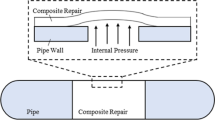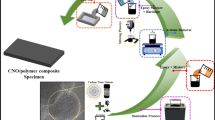Abstract
This paper proposes an automatic multi-objective optimization tool for the optimum design of a cracked pressure vessel with composite coating based on the non-dominated sorting genetic algorithm (NSGA-II) and maximum tangential strain energy density (MTSED) criterion. The proposed tool takes into consideration all the important parameters of the optimization of composite materials such as the angle, thickness, number, and material of each layer, as well as the effective parameters of fracture mechanics such as the orientation, length, and aspect ratio of cracks in the metallic liner of vessels. The optimization processes have been conducted for 3D longitudinal, circumferential and inclined semi-elliptical cracks in the sample composite pressure vessel and optimal stacking sequences and Pareto’s front for each kind of crack are presented. The in-plane and out of plane fracture envelop predicted by the MTSED criterion before and after optimization under mixed mode I/II/III have been investigated. The proposed tool is validated against collected results from existing literature and these results have largely agreed with each other.
Similar content being viewed by others
References
T. Le-Manh and J. Lee, Stacking sequence optimization for maximum strengths of laminated composite plates using genetic algorithm and isogeometric analysis, Composite Structures, 116 (2014) 357–363.
J. Bardy, X. Legrand and A. Crosky, Configuration of a genetic algorithm used to optimise fibre steering in composite laminates, Composite Structures, 94 (2012) 2048–2056.
L. Schmit and B. Farshi, Optimum laminate design for strength and stiffness, International Journal for Numerical Methods in Engineering, 7 (1973) 519–536.
G. Soremekun, Z. Gürdal, C. Kassapoglou and D. Toni, Stacking sequence blending of multiple composite laminates using genetic algorithms, Composite Structures, 56 (2002) 53–62.
R. Q. Sardinas, P. Reis and J. P. Davim, Multi-objective optimization of cutting parameters for drilling laminate composite materials by using genetic algorithms, Composites Science and Technology, 66 (2006) 3083–3088.
K. Ikeya, M. Shimoda and J.-X. Shi, Multi-objective free-form optimization for shape and thickness of shell structures with composite materials, Composite Structures, 135 (2016) 262–275.
B. Liang, N. Noda and S. Zhang, Two types of optimization of a cylindrical shell subjected to lateral pressure, International Journal of Pressure Vessels and Piping, 83 (2006) 477–482.
M. Walker and P. Y. Tabakov, Design optimization of anisotropic pressure vessels with manufacturing uncertainties accounted for, International Journal of Pressure Vessels and Piping, 104 (2013) 96–104.
M. Fakoor, S. M. N. Ghoreishi and H. Sabaghzadeh, Spacecraft component adaptive layout environment (SCALE): An efficient optimization tool, Advances in Space Research, 58 (2016) 1654–1670.
A. P. C. Cuco, F. L. de Sousa and A. J. S. Neto, A multi-objective methodology for spacecraft equipment layouts, Optimization and Engineering, 1 (2015) 165–181.
D. Abramson, A. Lewis, T. Peachey and C. Fletcher, An automatic design optimization tool and its application to computational fluid dynamics, Proceedings of the 2001 ACM/IEEE Conference on Supercomputing, ACM (2001) 25–25.
K. Deb, Multi-objective Optimization using Evolutionary Algorithms, John Wiley & Sons (2001).
X. Jin, Y. Zeng, S. Ding, B. Zhang, J. McLennan, J.-C. Roegiers, S. Shah and X. Bian, Weight function of stress intensity factor for single radial crack emanating from hollow cylinder, Engineering Fracture Mechanics, 170 (2017) 77–86.
M. A. Niasani, R. Ghajar, H. S. Googarchin and S. M. H. Sharifi, Crack growth pattern prediction in a thin walled cylinder based on closed form thermo-elastic stress intensity factors, Journal of Mechanical Science and Technology, 31 (2017) 1603–1610.
M. Aliabadi and A. Saleh, Fracture mechanics analysis of cracking in plain and reinforced concrete using the boundary element method, Engineering Fracture Mechanics, 69 (2002) 267–280.
M. Fakoor, S. M. N. Ghoreishi and N. M. Khansari, Investigation of composite coating effectiveness on stress intensity factors of cracked composite pressure vessels, Journal of Mechanical Science and Technology, 30 (2016) 3119–3126.
M. Aliha, A. Bahmani and S. Akhondi, Numerical analysis of a new mixed mode I/III fracture test specimen, Engineering Fracture Mechanics, 134 (2015) 95–110.
M. Fakoor and S. Ghoreishi, Comprehensive investigation of stress intensity factors in rotating disks containing three-dimensional semi-elliptical cracks, Applied Mathematics and Mechanics, 38 (2017) 1565–1578.
R. Tiberkak, M. Bachene and S. Rechak, Effect of crack on the impact response of plates by the extended finite element method (X-FEM), Journal of Mechanical Science and Technology, 28 (2014) 2243–2252.
J. Koo and Y. Choy, A new mixed mode fracture criterion: Maximum tangential strain energy density criterion, Engineering Fracture Mechanics, 39 (1991) 443–449.
L. Nobile, On the evaluation of the flexibility parameters of cracked beams based on the strain energy density theory, Theoretical and Applied Fracture Mechanics, 97 (2018) 454–456.
M. Mirsayar, A. Razmi and F. Berto, Tangential strain-based criteria for mixed-mode I/II fracture toughness of cement concrete, Fatigue & Fracture of Engineering Materials & Structures, 41 (2018) 129–137.
M. Ayatollahi and B. Saboori, Maximum tangential strain energy density criterion for general mixed mode I/II/III brittle fracture, International Journal of Damage Mechanics, 24 (2015) 263–278.
M. Aliha, A. Bahmani and S. Akhondi, A novel test specimen for investigating the mixed mode I+ III fracture toughness of hot mix asphalt composites — Experimental and theoretical study, International Journal of Solids and Structures, 90 (2016) 167–177.
S. Shi, Z. Sun, M. Ren, H. Chen and X. Hu, Buckling resistance of grid-stiffened carbon-fiber thin-shell structures, Composites Part B: Engineering, 45 (2013) 888–896.
Author information
Authors and Affiliations
Corresponding author
Additional information
Recommended by Associate Editor Gil-Ho Yoon
Seyed Mohammad Navid Ghoreishi received his Ph.D. in Aerospace Engineering from University of Tehran in 2018. His research interests include the fields of fracture mechanics, composite materials, and optimization.
Mahdi Fakoor is currently an Associate Professor in the Faculty of New Sciences and Technologies, Department of Aerospace Engineering, University of Tehran, Tehran, Iran. His research interests include the fields of fracture mechanics, composite materials, and optimization.
Rights and permissions
About this article
Cite this article
Ghoreishi, S.M.N., Fakoor, M. & Aminjafari, M. An automatic multi-objective optimization tool for the optimum design of a cracked pressure vessel with composite coating. J Mech Sci Technol 33, 4867–4875 (2019). https://doi.org/10.1007/s12206-019-0927-4
Received:
Revised:
Accepted:
Published:
Issue Date:
DOI: https://doi.org/10.1007/s12206-019-0927-4




